Introduction
The
most severe farm accidents often involve machinery. Missing
guards and shields, failure to recognize hazards and careless
operation are common factors in a majority of farm equipment
accidents.
Manufacturers attempt to build safety features into equipment. Some potential hazards can't be completely eliminated without interfering with machine function. For example, if the blades on a rotary mower were completely shielded, they would not cut material!
Timely
maintenance programs keep equipment in good operating condition--a
proven factor in accident prevention. It is the responsibility
of machinery operators to recognize hazards and take the necessary
steps to protect themselves and others.
Other pieces of farm equipment-not specifically designed for cutting-also harbour shear points. Grain augers fall into this category. Stay clear of shear points when machinery is in operation, and shut down all power when cleaning or adjusting equipment.

Pinch points on rotating parts can catch clothing, hands, arms and feet.
Pinch pointsMost pinch points are shielded on farm machinery. In the case of such devices as feed rollers, shielding is not possible. Hands, hair and clothing can be pulled into pinch points if caution is not exercised. Always replace guards and shields.
Even seemingly smooth shafts can catch and wrap clothing.
Wrap points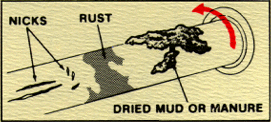 Any
exposed, rotating machine component is a potential wrap point.
Injuries usually occur when loose clothing or long hair catch
on and wrap around rotating shafts. Protruding shaft ends can
also become wrap points.
Any
exposed, rotating machine component is a potential wrap point.
Injuries usually occur when loose clothing or long hair catch
on and wrap around rotating shafts. Protruding shaft ends can
also become wrap points.
Shafts may appear to be smooth, but small nicks, mud, or rust increase wrap potential. It is almost impossible to escape once wrapping of clothing begins, because of the power involved. The more you try to pull away, the tighter the wrap becomes.
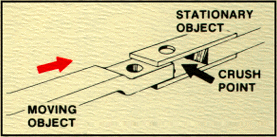
Hitches present typical crush points.
Crush pointsInjuries occur when operators shut off equipment, and attempt to clean or adjust a machine before components have completely stopped moving. Operator awareness is the key to safety around free-wheeling parts.
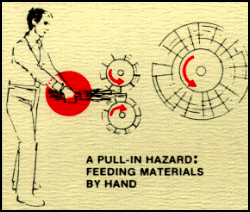
Machinery can pull you in faster than you can think to let go.
Pull-In points
Particles
of ground or chopped grain may be thrown hard enough to cause
injury. 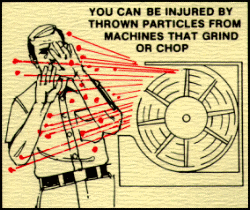
Compressed or stretched springs store considerable energy.
Springs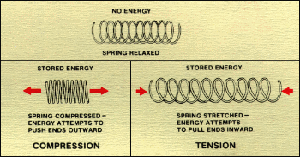 Springs are commonly used to help lift equipment, as shock absorbers,
and to keep belts tight. Springs may harbour potentially
dangerous stored energy. Always exercise caution when servicing
springs.
Springs are commonly used to help lift equipment, as shock absorbers,
and to keep belts tight. Springs may harbour potentially
dangerous stored energy. Always exercise caution when servicing
springs.
Before dismantling equipment, release any tension on the spring (if possible). Position yourself away from the direction of spring travel if the spring is compressed in any manner.
Hydraulic systemsHigh pressure blasts of hydraulic oil can injure eyes or other body parts. Follow instructions in the operator's manual to the letter when servicing hydraulic equipment. The following precautions are crucial:
Slips and falls often result from:
Publication #: F-017
The information and recommendations contained in this publication are believed to be reliable and representative of contemporary expert opinion on the subject material. The Farm Safety Association does not guarantee absolute accuracy or sufficiency of subject material, nor can it accept responsibility for health and safety recommendations that may have been omitted due to particular and exceptional conditions and circumstances.
Farm Safety Association Home Page
Disclaimer and Reproduction Information: Information in NASD does not represent NIOSH policy. Information included in NASD appears by permission of the author and/or copyright holder. More